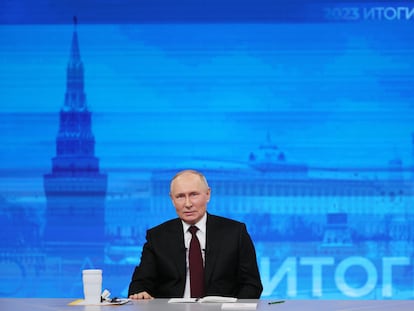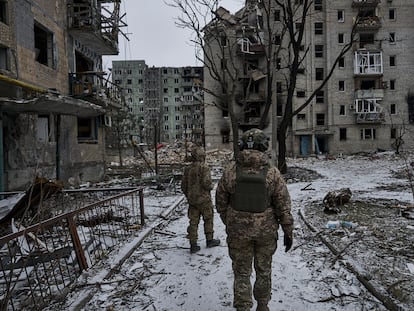Defeat Putin in Ukraine or settle for a draw?
Western support has helped Kyiv survive so far but it desperately needs more money and a new strategy
The flow of Western aid to Ukraine is facing serious challenges and the main culprits are Hungarian Prime Minister Viktor Orbán in the E.U. and isolationist Republicans in the U.S. With that out of the way, we can ask them bluntly: Do the E.U. and the U.S. want to defeat Putin in Ukraine, or will they settle for a draw?
There is no doubt that the E.U. and the U.S. have significantly aided Ukraine since the Russian invasion in February 2022. According to the Kiel Institute, European institutions have provided around €85 billion ($92.7 billion) in financial and military support to Ukraine through October 31. Bilateral aid from E.U. member states amounts to another €50 billion ($54.5 billion), while the U.S. has provided an additional $77.4 billion in financial aid and even more military equipment and munitions. The support has played a vital role in enabling Ukrainian forces to effectively withstand the much more powerful Russian invaders.
Europe has successfully curtailed its reliance on Russian gas and the West has imposed severe sanctions on Russia. While measures like the asset freeze have been more effective than the crude oil price cap and other penalties, the sanctions have undeniably made life difficult for the Kremlin.
On December 14, the European Union took a major step by initiating the process for Ukraine (and Moldova) to join the union. It’s a significant gesture and excellent news that sends a loud political message to Putin. Meanwhile, European countries are increasing their military spending, Finland recently joined NATO and Sweden is close to joining.
All of this sounds very impressive, but the facts tell a different story.
Western aid has been consistent but cautious, and weaponry is only supplied after lengthy deliberation and negotiation. Perhaps faster action would have yielded better results. Western leaders choose their words very carefully, and they hesitate to say anything about pursuing Russia’s total defeat in Ukraine. Instead, they talk about supporting Kyiv for as long as necessary, and preventing Putin from achieving victory.
Exercising caution is reasonable in light of Russia’s substantial nuclear arsenal and Putin’s declaration of willingness to employ it. The threat has effectively sowed doubt in every military move made by the West – does this cross the red line?
The facts show that new aid packages from the E.U. and the U.S. are not only blocked, but there has also been a significant decrease in support during the second half of 2023. New commitments and disbursements are much lower compared to previous periods.
There is no need to panic. The U.S. will probably come through in the end, and the E.U. will figure out how to circumvent Orbán’s opposition. A similar approach was taken when the U.K.’s David Cameron vetoed reforms need to bolster the euro in 2011. German and French leaders came up with a Plan B that got the job done. So the E.U. will probably continue to support Ukraine, potentially through bilateral aid packages.
But where does this path lead? The truth is that Putin has successfully overcome the poor planning of the initial invasion and bounced back after the remarkable Ukrainian counteroffensive in September 2022. Russia strengthened its frontline defenses and enhanced its domestic weapon production capabilities to effectively neutralize a Ukrainian counteroffensive in 2023.
A steady flow of aid to Ukraine is expected to prolong the current military deadlock. But this is by no means a foregone conclusion. Ukraine is driven by its national will to survive and Russia is led by an iron-fisted tsar. But both have critical vulnerabilities, and the West’s role will be crucial. On the Ukrainian side, cracks will start to appear from the morale-sapping lack of weaponry to combat the Russian war machine. On the Russian side, the socioeconomic cost of sustaining the war will become unsustainable.
Although it’s discouraging to see Putin’s consolidation of power, his position is not as secure as it seems. The resources he’s pouring into the war effort are immense. According to a study by the Stockholm International Peace Research Institute, 35% of the Russian government budget is allocated to military spending in 2024. This level of defense spending hasn’t been seen since the end of the Cold War and the collapse of the USSR, says U.K. Admiral Tony Radakin, who also noted that Russia spends more on war than on healthcare and education combined. A slight increase in Western support would further weaken the Russian position. No doubt Putin will fight to retain power at all costs. However, there are limits to how far he can go and how much his people will let him do.
Western countries collectively have the power to break the current stalemate, but have chosen to hold back. Putin has refrained from playing the nuclear card to defend against cautious escalations of Western military support. Why? Because China – a vital Russian ally – is clearly against it. However, we should not underestimate the risk of Putin using nuclear weapons to forestall total defeat in Ukraine, or to retain the strategically and symbolically significant Crimea. We must not underestimate the risk of reduced aid to Ukraine, which could lead to a stalemate or even a deterioration in Kyiv’s position.
What do we want? To continue investing billions to maintain a stalemate while the whole of Ukrainian society suffers? A Korea-style armistice with the country divided along current lines? Or a situation where Putin loses ground in Ukraine and faces challenges at home? The most urgent thing to do is unlock new funding for Ukraine. However, with one year to go before a new U.S. administration takes office, we must reevaluate the objective in Ukraine. Decreasing support for Kyiv, or even maintaining it at the current level, presents a higher risk for Europe than increasing support.
Sign up for our weekly newsletter to get more English-language news coverage from EL PAÍS USA Edition
Tu suscripción se está usando en otro dispositivo
¿Quieres añadir otro usuario a tu suscripción?
Si continúas leyendo en este dispositivo, no se podrá leer en el otro.
FlechaTu suscripción se está usando en otro dispositivo y solo puedes acceder a EL PAÍS desde un dispositivo a la vez.
Si quieres compartir tu cuenta, cambia tu suscripción a la modalidad Premium, así podrás añadir otro usuario. Cada uno accederá con su propia cuenta de email, lo que os permitirá personalizar vuestra experiencia en EL PAÍS.
¿Tienes una suscripción de empresa? Accede aquí para contratar más cuentas.
En el caso de no saber quién está usando tu cuenta, te recomendamos cambiar tu contraseña aquí.
Si decides continuar compartiendo tu cuenta, este mensaje se mostrará en tu dispositivo y en el de la otra persona que está usando tu cuenta de forma indefinida, afectando a tu experiencia de lectura. Puedes consultar aquí los términos y condiciones de la suscripción digital.











































